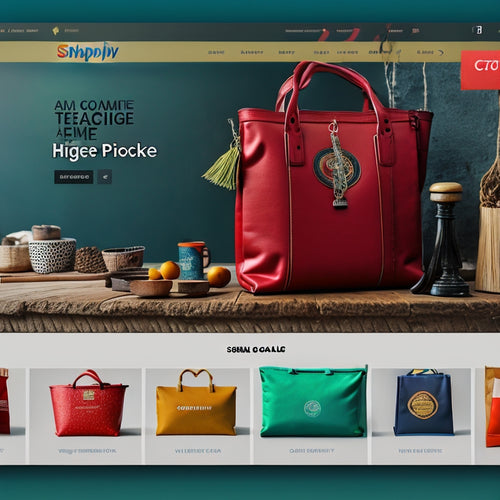
Unraveling E-Commerce Payment Methods: A Comprehensive Guide
Share
E-commerce payment methods have transformed, offering a range of secure and convenient options for businesses to facilitate seamless transactions and enhance customer experiences. Digital wallets, account-to-account payments, and Buy Now Pay Later options are increasingly popular, while payment security remains vital for building customer trust and loyalty. Payment gateways, ranging from hosted to offsite solutions, require careful evaluation of features, security, and scalability. Setting up payment processing demands technical expertise, security compliance verification, and user experience testing to guarantee a smooth transaction experience. As the e-commerce landscape continues to evolve, understanding the complexities of payment methods is essential for merchants looking to optimize their online transactions.
Key Takeaways
• E-commerce payments involve initiating and settling transactions securely, with digital wallets and BNPL options gaining popularity.
• Payment gateways act as virtual card machines, with features like supported payment methods, security certifications, and scalability being key considerations.
• Merchants must evaluate business needs and payment features for a seamless transaction experience, considering security, cost, and user experience.
• Effective payment processing integration demands technical expertise, security compliance verification, and user experience testing for a smooth payment process.
• Payment security is crucial for building customer trust and loyalty, with payment providers needing to ensure secure data transmission and compliance with regulations.
Understanding E-Commerce Payments
As the backbone of online transactions, e-commerce payments involve an intricate process of initiating and settling transactions, which necessitates a secure and efficient exchange of sensitive information between various stakeholders.
A digital wallets overview highlights the significance of secure payment methods, such as Google Pay and Apple Pay, which have gained popularity globally.
The growth of account-to-account (A2A) payments, facilitated by open banking adoption, and the rise of Buy Now Pay Later (BNPL) options, demonstrate the evolving landscape of e-commerce payments.
Ensuring payment security is paramount, as it directly impacts customer trust and loyalty.
Payment Gateway Options Explained
In the domain of e-commerce payment processing, the payment gateway acts as a virtual card machine, securely collecting and transmitting sensitive transaction data between the merchant's website and the payment processor. When selecting a payment gateway, merchants should consider key features such as payment methods supported, security certifications, and scalability.
There are three primary types of payment gateways: hosted, onsite, and offsite. Hosted gateways redirect customers to the payment processor's site, while onsite gateways gather payment information directly on the merchant's website. Offsite gateways utilize APIs for external payment processing.
Effective payment gateway integration is essential, requiring technical expertise and careful evaluation of the payment provider's compatibility with the e-commerce platform.
Setting Up Payment Processing
Setting up payment processing for e-commerce involves a strategic approach. Merchants must carefully evaluate their business needs and payment features to guarantee a seamless and secure transaction experience. When selecting a payment provider, factors such as security, cost, and user experience must be considered.
The integration process requires technical expertise to ensure a smooth and secure connection between the merchant's website and the payment gateway. Security considerations are crucial, with merchants needing to verify compliance with industry standards and regulations.
User experience testing is also critical to ensure a frictionless payment process that converts users into customers. By carefully evaluating payment provider selection, integration process, security considerations, and user experience testing, merchants can set up a reliable and efficient payment processing system that drives business growth.
Frequently Asked Questions
How Do I Handle Refunds and Chargebacks With My Payment Gateway?
To handle refunds and chargebacks, implement refund strategies such as timely processing and clear communication, and employ chargeback prevention measures like fraud detection, address verification, and dispute resolution to minimize losses and maintain a positive customer experience.
What Is the Ideal Payment Method Mix for My E-Commerce Business?
Crafting the ideal payment method mix for your e-commerce business is akin to discovering a treasure chest, where Customer Preferences and Revenue Streams harmonize. Balance digital wallets, credit/debit cards, A2A, and BNPL options to diversify revenue streams and cater to diverse customer needs.
Can I Use Multiple Payment Gateways for My Online Store?
Yes, you can use multiple payment gateways for your online store, a practice known as "gateway hopping," offering payment flexibility and diversifying transaction processing options to cater to various customer preferences and geographic requirements.
How Do I Ensure PCI-DSS Compliance With My Payment Processor?
Did you know 60% of businesses fail to adhere to PCI-DSS standards? To guarantee compliance, select a payment processor that follows stringent Data Encryption and Secure Storage protocols, guaranteeing sensitive customer information remains protected throughout the transaction process.
What Are the Average Payment Processing Fees for E-Commerce Transactions?
Average payment processing fees for e-commerce transactions vary, typically ranging from 1.5% to 3.5% plus a fixed rate per transaction, with some providers offering fee transparency and others imposing payment surcharges, making it essential to carefully review terms and conditions.
Related Posts
-
Top 4 Reasons Why Your Shopify Store Needs A HTML Sitemap (XML Sitemap Comparison)
This article examines the importance of a HTML sitemap for Shopify stores, in comparison to XML sitemaps. By analyzi...
-
A Guide to Shopify Sitemaps
This article presents a comprehensive guide to Shopify sitemaps, focusing on their benefits for search engine optimi...
-

How Do I Rank High on Shopify
This article aims to provide an informative and data-driven overview of strategies for achieving a high ranking on S...
